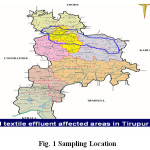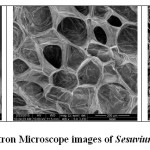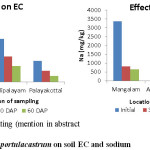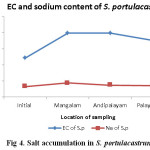Phytoremediation Potential of Sesuvium Portulacastrum on Remediating Salt Affected Soil
DOI: http://dx.doi.org/10.12944/CWE.12.3.20
Copy the following to cite this article:
Ramasamy J, Periasamy K, Venugopal B. Phytoremediation Potential of Sesuvium Portulacastrum on Remediating Salt Affected Soil. Curr World Environ 2017;12(3). DOI:http://dx.doi.org/10.12944/CWE.12.3.20
Copy the following to cite this URL:
Ramasamy J, Periasamy K, Venugopal B. Phytoremediation Potential of Sesuvium Portulacastrum on Remediating Salt Affected Soil. Curr World Environ 2017;12(3). Available from: http://www.cwejournal.org/?p=18404
Download article (pdf) Citation Manager Publish History
Select type of program for download
| Endnote EndNote format (Mac & Win) | |
| Reference Manager Ris format (Win only) | |
| Procite Ris format (Win only) | |
| Medlars Format | |
| RefWorks Format RefWorks format (Mac & Win) | |
| BibTex Format BibTex format (Mac & Win) |
Article Publishing History
| Received: | 2017-08-07 |
|---|---|
| Accepted: | 2017-11-16 |
Introduction
Soil and environment are under tremendous pressure due to industrial expansion and discharge of effluents. During the past few decades industrial activities have increased greatly with rapid economic growth, this accomplished severe environmental pollution. Textile industry is a diverse sector in terms of raw materials, processes, products and equipment and has a very complicated industrial chain. Its biggest impact on the environment is related to primary water consumption (80–100 m3/ton of finished textile) and waste water discharge (115–175 kg of COD/ton of finished textile, a large range of organic chemicals, low biodegradability, color and salinity). Therefore, reuse of the effluents represents an economical and ecological challenge for the overall sector 1. The textile effluents have a high concentration of salts, through their accumulation in different trophic levels of ecosystem ultimately cause serious environmental impact in the neighboring receptors like agricultural land and water bodies 2.
Salinity is one of the major abiotic constraints, manifesting as osmotic stress at an early phase and ionic stress at later phases of plant growth, consequently affecting plants survival mechanisms at cellular, tissue and whole plant level 3,4. More than 45 million hectares of irrigated land are affected by salt which account for 20% of total land and 1.5 million ha of land are taken out of production each year owing to high salinity levels 5,4. So, it is essential to reclaim the contaminated soil by natural way of using plants. Among the many feasible techniques, phytoremediation is a cost-effective and environmentally sound technology for remediation of salt affected sites.
Sesuvium portulacastrum (L.), a member of the family Aizoaceae, is an important halophyte in the category of “salt accumulator” plants which accumulates high salt concentration in their cells and tissues and overcomes salt toxicity by developing succulence. This plant has a distinct molecular and physiological flexibility that enables it to adapt and survive under various abiotic stress conditions 6-17. It has been observed that the growth characteristics of Sesuvium were improved upon exposure to optimum NaCl concentrations (100 to 400 mM) under in vitro and an increase in growth rate and halosucculence status (200 mM of NaCl) under ex vitro conditions6,7,8,9,10,11.
The ability of S. portulacastrum to survive in adverse environmental conditions recognizes it as a possible candidate for the environmental protection 12, 6, 8, 10, 13-17.The evidence for the ability of this halophyte to desalinise an experimentally salinised agricultural soil (grown for 189 days) is provided 7 and confirmed the growth potentials of test culture Hordeum vulgare (barley) on the desalinised soil. There was a marked absorption of Na+ ions by S. portulacastrum roots and their accumulation in the above-ground biomass up to 872 mg plant−1 and 4.36 g pot−1 (about 1 t ha−1). Similarly in a study among six species of halophytes studies, S. maritime and S. portulacastrum exhibited greater accumulation of salts in their tissues and higher reduction of salts in the saline land (upto 504 and 474 kg of sodium chloride respectively from the saline land from 1ha in 4 months time).Thus the characteristic feature of Sesuvium to accumulate high amount of salt in its tissues may be exploited for reducing salt levels in the potential agriculture soil and in the arid and semiarid regions by repetitive cultivation and harvesting of this plant in these areas. Hence, the present study aims to assess the phytoremediation potential of Sesuviumplant for the removal of salt from contaminated and salt enriched sites.
Materials and Methods
Sampling Location
Tamil Nadu textile city Tirupur, which has nearly 720 dyeing units, is ranked topmost in terms of generating hazardous waste. According to Tamil Nadu Pollution Control Board, an estimated 8,33,365.75 tons of hazardous waste is generated every year in Tirupur. Soil samples were collected from Andipalayam, Mangalam and Palayakottai villages of Tirupur District (Fig.1)
Soil sample collection
The Bulk soil samples were collected from dye and textile effluent contaminated sites, for conducting pot culture experiment. These villages represent the pollution status of Tirupur District and recorded high EC values (4.5 to 8.5 dSm-1). The initial physico-chemical characteristics of the soils samples were analysed by standard operating procedures 22.
 |
|
Plant sample collection and identification
Pichavaram is the second largest Mangrove forest in the world. The salty marsh area of Pichavaram supports many halophytes. Sesuvium being a coastal plant also act as an inland plant and a mangrove associate and has shown to have nursing effects in mangroves. Salt hyper accumulating plant Sesuvium portulacastrum samples were collected for remediating the salt contaminated soils. The collected salt hyper accumulating plant was identified and confirmed as Sesuvium portulacastrum through Botanical Survey of India and used to assess the salt removal potential. The chemical constituents of the Sesuvium plant was analysed by standard operating procedures 22, 26. Scanning electron microscope image of Sesuvium portulacastrum was also taken to observe the physiology of the plant (Fig.2).
 |
|
Experiment on salt uptake by Sesuvium portulacastrum
Pot culture and field study on salt uptake in high EC soils of Andipalayam, Mangalam and Palayakottai villages of Tirupur District was conducted to check the salt uptake potential, growth and establishment of Sesuvium portulacastrum plants. At periodical intervals (Month intervals) the soil and plant samples were collected and analysed for physico-chemical characteristics viz., pH, EC, Na, K, Ca and Mg, Cl and SO4 23 and the role played by Sesuvium plants to remove the salt level. Observations reveal that Sesuvium portulacastrum is a proven plant for reclaiming salt affected soils.
Salt enrichment
Soil was enriched with different concentration (2000, 3000, 4000 and 5000 mg kg-1) of NaCl. A control without any salt addition was maintained to study the salt uptake by the plants. Sesuvium portulacastrum plants were planted in the salt enriched soils and further observation on salt uptake, physico- chemical characteristics of soil and physiological changes in the plant were observed.
Statistical Analysis
The data on various characters studied during the investigation were statistically analysed by the method given by 24 at a (P<0.05).
Results and Discussion
Establishment of Sesuvium portulacastrum in dye and textile effluent contaminated soils (Andipalayam, Mangalam and Palayakottai villages) of Tirupur District was observed and the growth of the plant was good in contaminated soil. At periodical intervals (Month) the soil and plant samples were collected and analysed for physico-chemical characteristics and the role played by Sesuvium plants to remove the salt level was also studied (Fig 3 and 4).
 |
|
The initial EC of the soil is 13.04 dSm-1in Mangalam village and is reduced to 7.37 dSm-1(30 DAP) and 5.34 dSm-1(60DAP) (Fig. 3). In Andipalayam soil initial EC is 8.97 dSm-1 which decreased to 5.31 dSm-1 (30 DAP) and 3.29 dSm-1 (60DAP). In Palayakottai soil initial EC is 4.38 dSm-1 which decreased to 2.30 dSm-1 (30 DAP) and 1.24 dSm-1 (60DAP). The initial sodium content of the soil is 3372 mgkg-1 in Mangalam village is reduced to 820 mgkg-1 (30 DAP) and 643 mgkg-1 (60DAP) (Fig. 3). In Andipalayam soil initial sodium content is 2412 mgkg-1 and decreased to 558 mgkg-1 (30 DAP), 365 mgkg-1 (60DAP). In Palayakottai soil initial sodium content is 1500 mgkg-1 and decreased to 539 mgkg-1 (30 DAP), 361 mgkg-1 (60DAP).
At periodic intervals the role played by Sesuvium plants to remove the salt level was also studied by analyzing the plant characteristics such as pH, EC, Na, K, Ca and Mg (Fig. 4).
 |
|
The initial EC of the S. portulacastrum plant collected from Pitchavaram is 12.09 dSm-1 which increased to 19.93 dSm-1 in Mangalam village soil (30 DAP), 19.87 dSm-1 in Andipalayam village soil (30 DAP) and 17.59 dSm-1 in Palayakottai village soil (30 DAP). The initial sodium content of the S. portulacastrum plant is 3.2% which increased to 4.4% in Mangalam village soil (30DAP), 3.7% in Andipalayam village soil (30 DAP) and 3.5% in Palayakottai village soil (30 DAP) (Fig. 4). On comparing, it is found that the uptake of salts by Sesuvium plants collected from Pitchavaram was high in soil from Mangalam village than other village soils- Na: 3.2% to 4.4%, K: 1.2% to 1.5%, Ca: 0.06% to 0.14%, Mg: 0.05% to 0.24%. The evidence for the ability of this halophyte to desalinize an experimentally salinised agriculture soil is provided 7 and confirmed the growth potentials of test culture Hordeum vulgare on the desalinized soil. There was a marked absorption of Na + ions by S. portulacastrum roots and their above ground biomass up to 872 mg plant -1 4.36 g pot-1. Thus the characteristic feature of Sesuvium to accumulate high amount of salts in its tissue may be exploited for reducing salt levels in the potential agricultural soil and in the arid and semi arid regions by repetitive cultivation and harvesting of this crop in these areas 21.
Salt enrichment study
Sesuvium portulacastrum plants were planted in the salt enriched soils and further observation on salt uptake, physico- chemical characteristics of soil and physiological changes in the plant were observed.
The EC of the soil was found to considerably decrease throughout the study period of 90 days at four increasing concentrations of Na salt (Table 1). At a NaCl concentration of 2000 mgkg-1 80% reduction in soil EC was seen in 90 days interval. The highest EC reduction was observed in soil enriched with 4000 mgkg-1 of salt upto 82.5 % on the 90th day. It was also observed that among the four different concentrations of salt enriched soil, the EC reduction was upto 50.6% in the soil enriched with 4000 mgkg-1NaCl compared to other salt concentrations. Sesuvium plants established in salt enriched soils favored salt uptake which was evident in the decrease in Na in the soil (Table 1). The highest salt removal was seen in soil enriched with 3000 mgkg-1 of NaCl salt upto 81.82% in 90 days next to which 77.4% removal was observed in soil enriched with 2000 mgkg-1 of NaCl salt. Fifty seven percent salt removal was observed within a span of 30 days in soil enriched with 3000 mgkg-1 of NaCl salt whereas approximately 45-49% removal was seen in other concentrations.
Table 1: EC and Sodium content of the soil in salt enrichment experiment
|
NaCl concentration (mgkg-1) |
Days interval |
|||||||
|
EC (dsm-1) |
Na(mgkg-1) |
|||||||
|
0 |
30 |
60 |
90 |
0 |
30 |
60 |
90 |
|
|
2000 |
6.5 |
5.5 |
3.5 |
1.3 |
1990 |
1080 |
750 |
450 |
|
3000 |
7.7 |
4.8 |
4.2 |
1.8 |
2970 |
1250 |
980 |
540 |
|
4000 |
12.6 |
6.8 |
5.3 |
2.2 |
3970 |
2170 |
1750 |
1250 |
|
5000 |
15.8 |
7.8 |
6.4 |
4.9 |
4980 |
2530 |
2010 |
1550 |
Sesuvium plants established in salt enriched soils exhibited improved growth which was estimated in terms of shoot, root length (cm) and plant biomass (gpot-1) (Table 2). Root length of the plants increased from an average of 10.8 cm to 38.15 cm in 90 days. 73.9 and 73.8% increase in root length was seen in soil enriched with 2000 mgkg-1 and 5000 mgkg-1 in 90 days. respectively. Similarly, a 73.7% increase in shoot length was observed in soil enriched with 2000 mgkg-1 salt whereas 72.1 % increase was seen in 5000 mgkg-1 salt enriched soil in 90 days. Regarding plant biomass, a 94.32 % increase was seen in plants grown in 5000 mgkg-1 salt enriched soil in 90 days which indicates increased succulence in the presence of salt..
Table 2: Growth parameters of Sesuvium portulacastrum in salt enrichment experiment
|
NaCl concentration (mgkg-1) |
Days interval |
|||||||||||
|
Shoot length (cm) |
Root length (cm) |
Plant biomass (gpot-1) |
||||||||||
|
0 |
30 |
60 |
90 |
0 |
30 |
60 |
90 |
0 |
30 |
60 |
90 |
|
|
2000 |
12.5 |
25.8 |
37.3 |
47.6 |
10.3 |
22.1 |
30.5 |
39.5 |
25 |
125 |
257 |
350 |
|
3000 |
12.8 |
28.7 |
38.2 |
45.6 |
11.6 |
23.5 |
29.7 |
33.5 |
23 |
157 |
273 |
432 |
|
4000 |
13.5 |
23.8 |
39.6 |
48.3 |
10.8 |
25.6 |
30.9 |
39.5 |
26 |
160 |
289 |
425 |
|
5000 |
13.8 |
25.4 |
37.5 |
49.5 |
10.5 |
22.5 |
30.6 |
40.1 |
23.5 |
137 |
235.5 |
413.5 |
Analysis of soil and plant samples revealed that the plants were efficient in salt uptake from enriched soils. The electrical conductivity and sodium content were decreased in Sesuviumgrown soil enriched with different concentrations of Na. 77.8% of Sodium was removed from the soil in a span of 90 days. The two halophytes S. maritime and S. portulacastrum were reported to exhibit greater accumulation of salts in their tissues and high reduction of salts in the saline land and particularly, they could remove 504 and 474 kg of NaCl from the saline land from 1 ha in 4 months37.Decrease in soil EC and Na were reported 17when three halophytes Sesuvium portulacastrum L., Arthrocne mumindicumand Suaeda fruticosa L. were used for reclaiming salt affected soils. According to them, with regards to biomass production, shoot sodium concentration and the pot area, Sesuvium portulacastrum can extract 14 % of the salt that exists in the horizon 0-1 m of a soil having 10 % water and a salt concentration that exceeds 200 mMNaCl. Also, considerable increase in root and shoot length and biomass of S. portulacastrum plants were observed throughout the study period. Sesuvium can optimally uptake saline ions and carbon resources from the medium and allocate it to different parts of the plant resulting in increase succulence subsequently improving the growth, biomass and net photosynthesis rate of the plant 6,7, 15, 20, 25-27, 28-34. Sesuvium plants accumulate the inorganic salts in the vacuole, mainly NaCl and organic solutes in the cytoplasm. Na+ uptake into vacuoles requires Na+/H+ antiporters in the tonoplast and H+ ATPases and perhaps PPIases to provide the proton motive force. Halophytes vacuoles may have a modified lipid composition to prevent the leakage of Na+ back to the cytoplasm 12.
Conclusion
Sesuvium portulacastrum is a salt hyper accumulating halophyte which compartmentalizes the toxic Na+ in the vacuoles and therefore membrane bound transport system regulating cytosolic ( Na+, K+ and Ca++) and ion accumulation by increasing the vacuolar volume. Environmentally, the plant’s potential has been checked for its survival under different abiotic stress conditions that includes salinity, drought and heavy metal accumulation which makes Sesuvium a useful species as a heavy metal pollution indicator and for predicting soil salinity. Thus the characteristic feature of Sesuvium to accumulate high amount of salt in its tissues may be exploited for reducing salt levels in the potential agriculture soil and in the arid and semiarid regions by repetitive cultivation and harvesting of this plant in these areas.
Acknowledgement
The authors are acknowledged to the Department of Environmental Sciences, TamilNadu Agricultural University, Coimbatore for carried out this research work.
References
- Emongor, V., Nkegbe, E., Kealotswe, B., Koorapetse, I., Sankwasa, S. andKeikanetswe, S. Pollution Indicators in Gaborone Industrial Effluent, Journal of Applied Sciences,5: 147-150 (2005).
- Li Rosi O, Casarci M, Mattioli D, Florio L D, Best available technique for water reuse in textile SMEs, Desalination, 206: 614–619 (2007).
- Bharti, P. K. andChauhan, A. Environmental Biotechnology and Application. Discovery Publishing House, New Delhi. India, p. 248 (2013).
- Hasegawa, P. M., Bressan, R. A., Zhu, J. K. andBohnert, H. J. Plant cellular and molecular responses to high salinity. Annual Review of Plant Physiology and Plant Molecular Biology, 51:463–499 (2000).
- Munns, R. and Tester, M. Mechanisms of salinity tolerance. Annual Review of Plant Biology, 59: 651–681(2008).
- Abdelly, C., Lachaal, M., Grignon, C., Soltani, A. and Hajji,M.Associationépisodiqued'halophytesstricts et de glycophytesdans un écosystèmehydromorphesalé en zone semi-aride,Agronomie, 15: 557-568 (1995).
- Rabhi, M., Giuntini, D., Castagna, A., Remorini, D., Baldan, B., Smaoui, A., Abdelly, C. and Ranieri,A.Sesuviumportulacastrum maintains adequate gas exchange, pigment composition, and thylakoidproteins under moderate and high salinity. Journal of Plant Physiology,167(16): 1336-1341 (2010a).
- Rabhi, M., Ferchichi, S., Jouini, J., Hamrouni, M. H., Koyro, H. W., Ranieri, A., Abdelly, C. andSmaoui, A.Phytodesalination of a salt-affected soil with the halophyte Sesuviumportulacastrum to arrange in advance the requirements for the successful growth of a glycophytic crop, Bioresource Technology, 101:6822–6828 (2010b).
- Lokhande, V. H., Nikam, T. D., Patade, V. Y. andSuprasanna, P. Morphological and molecular diversity analysis among the Indian clones of Sesuviumportulacastrum, Genetic Resources and Crop Evolution, 56:705–717 (2009a).
- Lokhande, V. H., Nikam, T. D. andSuprasanna, P.Sesuviumportulacastrum (L.) L., a promising halophyte: cultivation, utilization and distribution in India. Genetic Resources and Crop Evolution, 56(5):741–747 (2009b).
- Lokhande, V. H., Srivastava, S., Patade, V. Y., Dwivedi, S., Tripathi, R. D., Nikam, T. D. andSuprasanna, P. Investigation of arsenic accumulation and tolerance in Sesuviumportulacastrum (L.) L. Chemosphere, 82(4): 529-534 (2010a).
- Lokhande, V. H., Nikam, T. D. andSuprasanna, P. Biochemical, physiological and growth changes in response to salinity in callus cultures of Sesuvium portulacastrum, Plant Cell, Tissue and Organ Culture, 102:17–25 (2010b).
- Lokhande, V. H., Nikam, T. D. andSuprasanna, P. Differential osmotic adjustment to iso-osmotic salt and PEG stress in vitro in the halophyte Sesuviumportulacastrum, Journal of Crop Science and Biotechnology, 13(4):251–256 (2010c).
- Lokhande, V. H., Nikam, T. D., Patade, V. Y., Ahire, M. L. andSuprasanna, P. Effects of optimal and supra-optimal salinity stress on antioxidative defense, osmolytes and in vitro growth responses in Sesuviumportulacastrum, Plant Cell, Tissue and Organ Culture, 104:41–49 (2011a).
- Lokhande, V. H., Srivastava, S., Patade, V. Y., Dwivedi, S., Tripathi, R. D., Nikam, T. D. andSuprasanna, P. Investigation of arsenic accumulation and tolerance in Sesuviumportulacastrum (L.) L. Chemosphere, 82(4):529–534 (2011b).
- Lokhande, V. H., Srivastava, A. K., Srivastava, S., Nikam, T. D. andSuprasanna, P. Regulated alterations in redox and energetic status are the key mediators of salinity tolerance in the halophyte Sesuviumportulacastrum (L.) L., Plant Growth Regulation, 65(2):287–298 (2011c).
- Moseki, B. and Buru, J. C. Ionic and water relations of Sesuvium portulacastrum (L). Scientific Research and Essays, 5(1):35–40 (2010).
- Zaier, H., Ghnaya, T., Lakhdar, A., Baioui, R., Ghabriche, R., Mnasri, M., Sghair, S., Lutts, S. andAbdelly, C. Comparative study of Pbphytoextraction potential in Sesuviumportulacastrum and Brassica juncea: tolerance and accumulation. Journal of Hazardous Materials, 183(1-3): 609-615 (2010a).
- Zaier, H., Mudarra, A., Kutscher, D., Fernandez de la Campa, M. R., Abdelly, C. andSanz-Medel, A. Induced lead binding phytochelatins in Brassica juncea and Sesuviumportulacastruminvestigated by orthogonal chromatography inductively coupled plasma-mass spectrometry and matrix assisted laser desorption ionization-time of flight-mass spectrometry. AnalyticaChimicaActa, 671(1-2): 48-54 (2010b).
- Short, D. C. and Colmer, T. D. Salt tolerance in the halophyte Halosarciapergranulata pergranulata. Annals ofBotany, 83:207–213 (1999).
- Ghnaya, T., Nouairi, I., Slama, I., Messedi, D., Grignon, C., Abdelly, C. andGhorbel, M. H. Cadmium effects on growth and mineral nutrition of two halophytes: Sesuviumportulacastrum and Mesembryanthemumcrystallinum. Journal of Plant Physiology, 162(10):1133– 1140 (2005).
- Standard methods for the examination of water and waste water, 21st edn. American Public Health Association, Washington, DC (2005)
- Ghnaya, T., Slama, I., Messedi, D., Grignon, C., Ghorbel, M. H. andAbdelly, C. Effect of Cd2+ on K+, Ca+ and N uptake in two halophytes Sesuviumportulacastrum and Mesembryanthe mumcrystallinum: Consequences on growth. Chemosphere, 67(1):72–79 (2007a).
- Gomez, K.A. and Gomez. A. A.Statistical Procedures for Agricultural Research, John Wiley and Sons, New Delhi, p. 680 (1984).
- Ravindran, K. C., Venkatesan, K., Balakrishnan, V., Cehllappan, K. P. and Balasubramanian, T. Restoration of saline land by halophytes for Indian soils, Soil Biology and Biochemistry, 39:2661– 2664 (2007).
- Jackson, M. L.L.Soil Chemical Analysis. Prentice Hall of India (Pvt) Ltd., New Delhi, p.275 (1973).
- Venkatesalu, V. andChellapan, K. P. Photosynthetic characteristics of Sesuviumportulacastrum under salt stress, Photosynthetica, 28:313–316 (1993a).
- Venkatesalu, V. andChellappan, K. P. Photochemical characteristics of Sesuvium portulacastrum under sodium chloride stress, Photosynthetica, 29:139–141(1993b).
- Messedi, D., Labidi, N., Grignon, C. andAbdelly, C. Limits imposed by salt to the growth of the halophyte Sesuviumportulacastrum, Journal of Plant Nutrition and Soil Science, 167:720–725 (2004).
- Ghnaya, T., Slama, I., Messedi, D., Grignon, C., Ghorbel, M. H. andAbdelly, C. Cd-induced growth reduction in the halophyte Sesuviumportulacastrum is significantly improved by NaCl. Journal of Plant Research, 120:309–316 (2007b).
- Slama, I., Messedi, D., Ghnaya, T., SavouÅ•e, A. andAbdelly, C. Effects of water-deficit on growth and proline metabolism in Sesuviumportulacastrum, Environmental and Experimental Botany, 56:231–238 (2006).
- Slama, I., Ghnaya, T., Hessini, K., Messedi, D., Savoure, A. andAbdelly, C. Comparative study of the effects of mannitol and PEG osmotic stress on growth and solute accumulation in Sesuviumportulacastrum, Environmental and Experimental Botany, 61:10–17 (2007a).
- Slama, I., Ghnaya, T., Messedi, D., Hessini, K., Labidi, N., Savoure, A. andAbdelly, C. Effect of sodium chloride on the response of the halophyte species Sesuviumportulacastrum grown in mannitol-induced water stress, Journal of Plant Research, 120:291–299 (2007b).
- Slama, I., Ghnaya, T., SavouÅ•e, A. andAbdelly, C. Combined effects of long-term salinity and soil drying on growth, water relations, nutrient status and proline accumulation of Sesuviumportulacastrum, ComptesRendusBiologies, 331:442–451 (2008).








